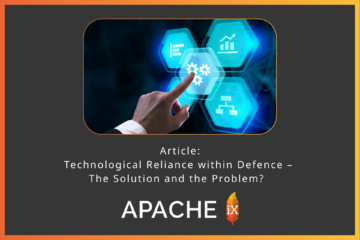

Since the latter half of the 20th century the international defence industry has been dominated by a small group of US and European defence contractors – the primes – such as Lockheed Martin, BAE Systems, Boeing and Northrop Grumman. These companies developed their reputations through producing complex, high-cost military platforms like fighter jets, aircraft carriers, and nuclear submarines, designed for traditional state-on-state conflicts. Many of these primes have become deeply embedded within the UK’s defence procurement, strategy and innovation ecosystems, allowing them to benefit from close partnership with government. However, the changing state of modern warfare, where asymmetric insurgencies, cyber-threats, and drone combat have become far more common has exposed the limitations of the prime model and renewed calls for greater agility and innovation within the sector. For this reason, a group of New Generation Defence Companies (NGDCs) have gained prominence and offer a notably different approach to the traditional primes.
From the Valley to the Battlefield
NGDCs, including organisations like Palantir, Anduril, Helsing and Origin Robotics, represent a shift away from heavy platforms and towards software, artificial intelligence, and autonomous systems as core defence capabilities. As discussed by Merrill (2024), these organisations often operate with a Silicon Valley mentality characterised by speed, adaptability, and high risk-appetite, contrasting against the slower, more risk-averse nature of traditional defence primes. Furthermore, these organisations increasingly leverage venture capital and retail investment practices to fuel growth, allowing these organisations to rapidly prototype, test, and deploy solutions in far shorter timeframes (Schwarz, 2025).
Palantir, founded in 2003, is perhaps the most prominent example of an NGDC. This organisation aims to support government and intelligence services in making more effective, secure, and responsible use of their data (Gutman, 2021). As of 2024, Palantir has a market capitalisation of over $330 billion and has secured contracts with the US’ Department of Defence (DoD) and UK’s National Health Service (NHS). Whilst these contracts underscore the organisation’s growing role in complex, safety-critical environments, Palantir has received increased criticism for its role in mass surveillance programmes, partnership with the US’ Immigration and Customs Enforcement (ICE), and alleged use of its products by Israel in Gaza (McCarroll, 2019; Gray, 2025).
The Shape of Things to Come
The emergence of New Generation Defence Companies holds the potential to reshape the UK’s defence landscape and introduces opportunities and challenges. According to Caldwell (2024), these organisations emphasise rapid development, software integration, and agile design, which may pressure the traditional primes to shorten R&D cycles, strengthen digital capabilities, and experiment with more modular, flexible product strategies. Furthermore, NGDCs have often capitalised on breakthroughs in drone autonomy, cloud computing, and large language models faster than the traditional primes (Dotterrer et al., 2023). Ultimately, these benefits could prompt the UK government, Ministry of Defence, and the traditional primes to rethink procurement models, partnerships, and risk tolerance to remain competitive.
This potential NGDC hold can be observed in Ukraine’s Operation Spiderweb, a covert operation that successfully smuggled drones into Russia via civilian trucks and damaged over a third of Russia’s strategic bomber fleet. The drones, developed by the Ukrainian-based NGDC, First Contact, were estimated to cost just a few hundred thousand dollars, yet caused over $7 billion in damage, leading Chahal (2025) to highlight the potential for NGDCs to achieve strategic impact at a far lower cost than the traditional primes.
Prime Opportunity?
Despite these successes, NGDCs also face significant challenges that could impact their long-term role in the UK defence sector. While their Silicon Valley mentality and rapid prototyping capabilities offer promising avenues for greater agility and innovation, primes retain advantages in reliability, security, and large-scale production capacity – areas where NGDCs remain unproven.
For instance, while large NGDCs like Palantir have achieved profitability, many smaller firms rely on frequent funding rounds to maintain operations, making them more vulnerable to fluctuations in investor sentiment, the availability of capital, and the cost of borrowing. Furthermore, Hadlington et al. (2024) determined that many NGDCs place strong emphasis on software-focused products and have capitalised on the current sentiment that AI and software could provide a solution to almost all challenges. While operating under this perception has allowed NGDCs to increase the speed of their innovation and prototyping, it also risks underestimating the complexity of integrating such technologies into defence systems that must meet reliability, security, and interoperability standards. For this reason, the long-term influence of NGDCs in the UK defence sector will depend not only on their ability to sustain innovation, but also on whether they can meet the enduring demands of reliability, interoperability, and trust that national security requires.
References
MERRILL, A. 2024. Start-Up War: Venture Capital, Silicon Valley, the Pentagon and the Wars Yet-to Come. University of Toronto (Canada).
SCHWARZ, E. 2025. From blitzkrieg to blitzscaling: Assessing the impact of venture capital dynamics on military norms. Finance and Society, 1-24.
GUTMAN, B. 2021. Palantir’s Surveillance Empire: A Story of American Policing, Patriotism, and Profit.
MCCARROLL, E. 2019. Weapons of mass deportation: Big data and automated decision-making systems in immigration law. Geo. Immigr. LJ, 34, 705.
GRAY, C.H. 2025. ‘Ai at war’, AI, Sacred Violence, and War—The Case of Gaza, pp. 79–106.
CALDWELL, D. T. 2024. Defense Innovation at an Inflection Point: The Rise of New Primes like Anduril and the Changing Military-Tech Ecosystem. Open Access Cases, 1.
DOTTERRER, K., SCHRAMKE, B. A., PONCE-PORE, A. E., STURZINGER, E. M., HARGROVE, H. & LOWRANCE, C. J. Enabling enterprise autonomy development with a unified data infrastructure. Big Data V: Learning, Analytics, and Applications, 2023. SPIE, 33-47.
CHAHAL, B. A. S. 2025. Operation ‘Spider’s Web’: Ukraine’s Evolution In Asymmetric Warfare.
HADLINGTON, L., KARANIKA-MURRAY, M., SLATER, J., BINDER, J., GARDNER, S. & KNIGHT, S. 2024. Public perceptions of the use of artificial intelligence in Defence: a qualitative exploration. AI & SOCIETY, 1-14.


